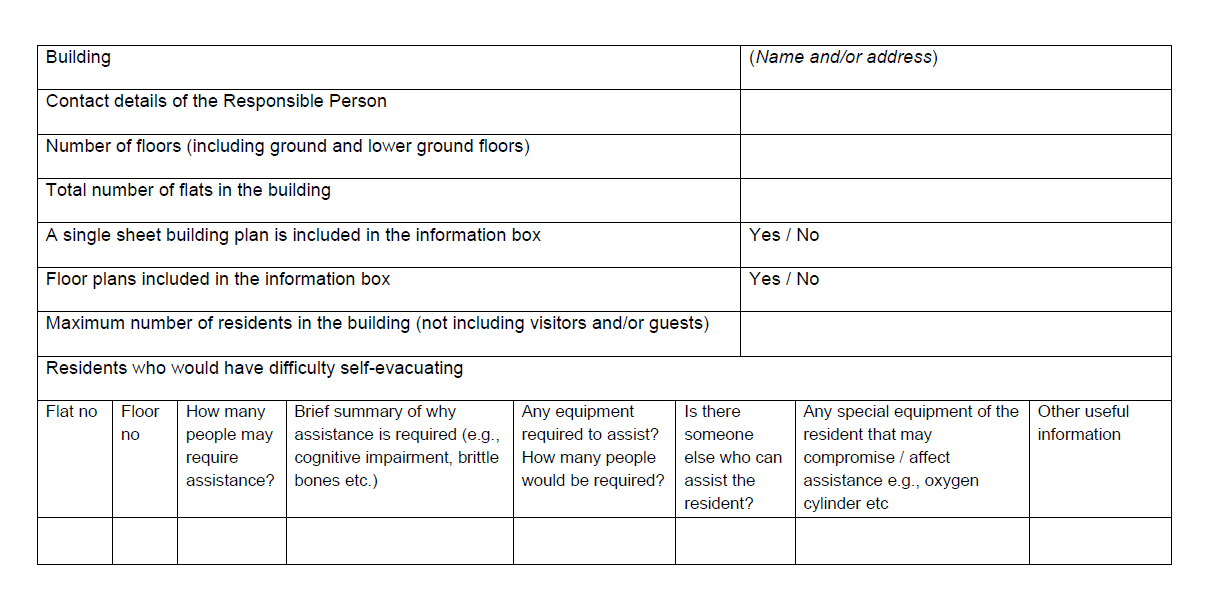-
Contact
Sales & Customer Service
0800 612 6537 support@safelincs.co.uk Live ChatDelivery Enquiries
0800 077 6149 - Resources
Fire & Safety Solutions
CALL OUR TEAM NOW 0800 612 6537
Also FREE from UK mobiles
Free Delivery
on 100s of Products
Live Chat - Online
Instant help & Advice
Trade Discounts
and exclusive pricing
0% Credit Available
Open an account now
5 Star Customer Feedback
Differences between GEEPs and PEEPs
In light of Phase II of the Grenfell inquiry being published it has highlighted and made recommendations for PEEPs to be implemented in high-rise residential buildings. While the full scope of the requirements are still not known it is likely to affect many building owners, landlords and Councils, and social housing groups. While the law will focus on high-rise blocks of flats, defined as being at least 18 metres in height or having at least seven storeys, there will likely be a duty of care for all landlords to have a GEEP and / or PEEPs in place to protect their residents in the event of a fire.
Knowing what to do in an emergency is important, and being able to evacuate your building safely and effectively is essential for protecting others.
Each one sets out what to do in an emergency and a copy of these should be kept in the Premises Information Box (PIB), for both the Responsible Person for the building and the Fire Brigade to have access to. These are also referred to as Secure Information Box (SIB) and depending on whether the box is to be kept indoors or outdoors they will need to meet certain quality standards.
What is a General Emergency Evacuation Plan (GEEP)?
A General Emergency Evacuation Plan (GEEP) outlines a building’s layout, evacuation procedures, and the equipment and communication devices used during emergencies. While beneficial for all, GEEPs are specifically designed to provide essential information to those with restricted mobility or who cannot evacuate unaided, the information they need to evacuate safely and effectively.
In public buildings, GEEPs must be prominently displayed for all residents and guests. Key elements, such as evacuation procedures, should be clearly visible with notices for those requiring assistance. Regular drills and a system to test these methods are essential to ensure that all occupants are familiar with the procedures and have adequate training and knowledge of the building’s layout and evacuation and fire-fighting equipment.
What is a Personal Emergency Evacuation Plan (PEEP)?
A Personal Emergency Evacuation Plan (PEEP) is a customized escape plan designed for individuals who may not be able to reach safety unaided or within a sufficient amount of time during an emergency.
Unlike a General Emergency Evacuation Plan (GEEP), a PEEP is specifically tailored to an individual’s needs to ensure their safety during an evacuation. The plan is developed in collaboration with the individual to agree on the evacuation method including any equipment that may be required. It details the escape routes and identifies the people who will assist in the evacuation and any training needed including any refresher training.

Similar to a GEEP, the PEEP should be regularly updated and tested to ensure all relevant people are familiar with the procedure and have adequate training and knowledge of the building’s equipment and layout. The PEEP should be distributed to everyone involved and properly filed.
Visitors would likely come under this under these new regulations – they will need to self-identify as requiring a temporary PEEP while staying with family or friends.
How do I know if I need a GEEP or PEEP?
As the owner, or responsible person, for a residential building you will need a GEEP.
Knowing whether you need a PEEP, however, isn’t as straightforward. The tenant will need to self-identify that they need a PEEP. It is important that creating the PEEP is done in conjunction with the tenant. It is likely that anyone with a PEEP will need to have the information contained in it updated regularly, potentially every 6 months to ensure the information is as up-to-date as possible. Also, any changes in tenancy will need to be logged and any residents PEEPs removed promptly, to ensure the information for the Emergency Services is correct.
There are two types of PEEPs: permanent and temporary. A permanent PEEP is needed for any person who has:
- Mobility impairments
- Sight impairments
- Hearing impairments
- Cognitive impairments - e.g. Alzheimer's, Autism
- Other relevant circumstances - e.g. prescribed medication (sleeping tablets), substance or alcohol dependency
A temporary PEEP is for anyone with:
- Short-term injuries (i.e. a broken leg)
- Temporary medical conditions
- Those in the later stages of pregnancy or early post-partum
What is included in a GEEP?
A General Emergency Evacuation Plan (GEEP) typically includes several key components to ensure the safety of all building occupants during an emergency. Here are some common elements:
- Building Layout: Detailed maps showing all exits, stairwells, and the location of emergency equipment
- Evacuation Procedures: Detailed guidelines on safely evacuating the building, including designated assembly points away from the building
- Communication Devices: Information and training on the use of alarms, public address systems, and other communication tools to alert occupants
- Emergency Equipment: Locations and instructions for using fire extinguishers, first aid kits, and other emergency equipment
- Assistance for Individuals with Disabilities: Detailed procedures and evacuation equipment for aiding individuals with restricted mobility or other disabilities
- Roles and Responsibilities: Clear definitions of the roles and responsibilities of the Responsible Person, including any volunteer fire wardens / marshals and emergency personnel during an evacuation
- Training and Drills: Regular updates of any changes and where possible, evacuation drills to ensure everyone is familiar with the procedures. Ensure that anyone with roles and responsibilities are sufficiently trained.
- Emergency Lighting and Signage: Adequate emergency lighting provision and visible signs and notices throughout the building to guide occupants to the nearest exit during an emergency
These components help ensure that everyone in the building knows what to do and where to go in the event of an emergency.
What is included in a PEEP?
Workplace PEEPs have been around for many years, as a result of the Grenfell Inquiry it is likely that a residential PEEP will be required for anyone living in a high-rise building (at least 18 metres in height or having at least seven storeys) who would not be able to self-evacuate.

Each resident will need to self-evaluate to say whether they need a PEEP or not and will need to give the necessary information to the Responsible Person, they will need to fill in a form that will require the following information:
- Name of Resident
- Full Address (to include flat and floor numbers)
- Contact details in an emergency
Ensure that the resident is aware of the general fire safety for the building, if not, ensure that they are made aware.
Document the reasons for needing a PEEP
This is an important part of collating all the information on the individuals requirement for a PEEP when discussing this with the resident, if required, ensure to include an interpreter, next of kin, chaperone or neighbour/s (who are willing to assist with the evacuation).
- Do they need any specialist equipment e.g. oxygen tank, other evacuation aid or chair?
- A written description of their PEEP; things to consider and include would be:
- An agreed place of safety to evacuate to that is away from the building
- The quickest and safest route to get there, including a contingency plan should this route be blocked
- Name (and address) of anyone willing to assist with their evacuation with a back-up person willing and able to assist in an emergency
- Any specialist equipment required and its location
- Access required by RP or FRS to flat (key code, break down door)
- What should NOT be attempted by the RP, Volunteer or FRS in the case of a rescue
- Has the plan been tested?
- When will be the review date (e.g. every 6 months or 1 year)
- Their consent for the information to be shared with the FRS
- Date
- Name and signature of the Responsible Person
- Name and signature of the Resident
- Name and signature of any other party involved (e.g. neighbour, next of kin etc.)
All this information will then be collated and then put into an overview template (see below) so that the Fire & Rescue Service can quickly see where in the building that the people are who have PEEPs in place. It is unlikely, that the responsibility will lie with the FRS to evacuate these people, this will be down to the Responsible Person and any volunteers that have agreed to assist with evacuating.

For further reading please see the Government Consultation for PEEPs in high-rise residential buildings



















